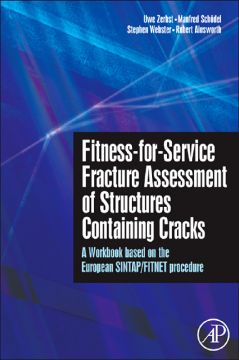
BOOK
Fitness-for-Service Fracture Assessment of Structures Containing Cracks
Uwe Zerbst | Manfred Schödel | Stephen Webster | Robert Ainsworth
(2013)
Additional Information
Book Details
Abstract
The purpose of Fitness-for-Service Fracture Assessment of Structures Containing Cracks is to facilitate the use of fracture mechanics based failure assessment procedures for the evaluation and design of structures and components. All practical structures contain flaws and the optimum combination of cost efficiency and safety whilst achieving the required capability, can only be realised by using state of the art methods such as that represented by the European flaw assessment method SINTAP/FITNET to analyse the safety risk. This book is written by practitioners with extensive experience in both the development and use of integrity assessment methods and provides comprehensive information on the basic principles and use of analytical flaw assessment. It provides an introduction to the method, its background, how it can be applied, its potential and, importantly, its limitations. The explanations are complimented by using a large number of worked examples and validation exercises which illustrate all aspects of the procedure. In addition, for students and engineers who are new to the subject, a comprehensive glossary of basic terms used in fracture mechanics based integrity evaluations is included.
The topics addressed include:
- Crack driving force (CDF) and failure assessment diagram (FAD) type analyses
- Preparation of the input parameters (crack dimensions, stress-strain properties, fracture toughness, statistical aspects)
- Determination of the model parameters, (stress intensity factor and yield load solutions)
- Treatment of combined primary and secondary loading, together with residual stress effects
- Analysis of the effect of constraint effects (treatment of small defects and section size effects)
- Treatment of mixed mode loading
- Consideration of the influences of strength mismatch
- Reliability aspects
- Comprehensive description of the use of structural integrity methods to optimise cost effectiveness and safety
- Detailed description of how to evaluate the integrity of structures containing cracks
- Valuable background information for understanding the methods, their potential and limitations
- Large number of worked examples, which demonstrate all aspects of the methods
- Descriptive, readable writing style
- Applicable to a wide range of interests, from the student (university or self study) to the expert who requires a 'state of the art' document
"The comprehensiveness of the compilation of the SINTAP/FITNET Procedure in this book, clear outline, worked examples, numerous formulas for important relationships, clear illustrations, an illustrated glossary, a comprehensive subject index: the level of presentation of all these items is excellent and may animate the reader to spend more time on the book than he may have had in mind before he started. This book is written by key experts in the field and is highly recommendable to a wide readership, in particular those engineers who want to be made aware of the latest state of the art of structural assessment." -- Dr. Karl-Heinz Schwalbe, Consultant, Germany
The authors should be commended for making a very useful contribution to the area of fracture assessment of metallic structures. The book comprises a good mix of theory and practical procedures, which are complimented by many worked examples and validation exercises." -- Dr Xiang Zhang, Cranfield University, U.K.
"...a very well written, articulate and informative presentation of the European flaw assessment method SINTAP/FITNET... The explanations are complemented by extensive and detailed worked examples and validation exercises illustrating the use of the procedure. This is a very welcome aspect of the book, since frequently the scientific and technical literature provides insufficient help to those wishing to apply the results presented. In summary, this book is an important contribution to the field of structural integrity, failure prevention and assessment, of great value to engineers and scientists working in a wide variety of sectors where metallic structures are used." -- Professor P.M.S.T. de Castro, Universidade do Porto, Portugal
